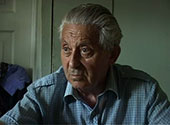
Arkadii Burshtein was born in Sobolivka in 1928. His father was a tailor. He attended a Yiddish school for four years, and then finished his education in a Ukrainian school. He survived in labor camps in the Reichkommissariat Ukraine before making his way into Transnistria. After the war he returned to Haysyn, where he worked as chief engineer in a garment factory.
Other Interviews:
Sobolivka AncedoteMy Grandfather and the Priest
My Grandfather's Observance
"they wanted us to stay alive."
Speaking Yiddish
The Mass Grave in Sobolivka
Arkadii's Gefilte Fish
Sobolivka
Haysyn, Ukraine
Settlement and occupational patterns in pre-war Ukraine were sharply demarcated by ethnicity. Jews tended to live in shtetlekh, where their residences were concentrated around the main square, and where they worked as artisans and merchants. In this clip, Arkadii Burshtein remembers that the Christians lived around the shtetl, and the Jews lived within it. This impression of two starkly demographically distinct regions is supported by census data. According to the 1926 census, whereas only 11 percent of all Ukrainians--Jews and non-Jews--lived in urban centers, 91.4 percent of Ukrainian Jews were urban. Even the most heavily Jewish cities were still surrounded by non-Jewish countryside. Jews were also distinguished by occupation, and many people we spoke with drew sharp distinctions between the Christian peasants who lived in the countryside and the Jewish artisans who lived in the city. Again, the census figures confirm that Jews dominated certain handicrafts, such as tailors, cobblers, glaziers, coopers, and coachmen.
